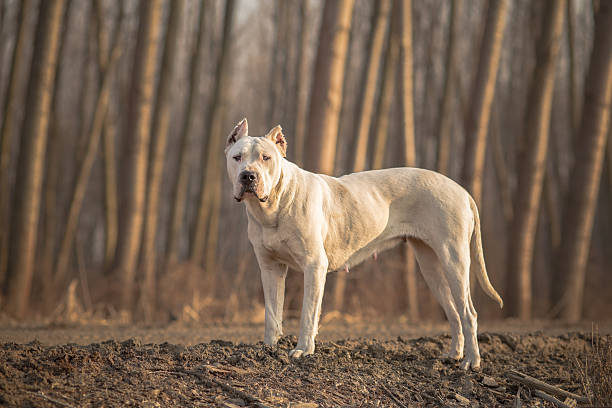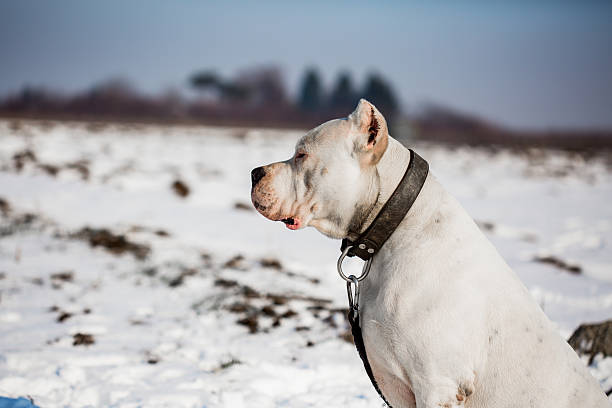Dogo Argentino

Breed History:
The Dogo Argentino was developed in Argentina in the 1920s by Dr. Antonio Nores Martínez, who aimed to create a strong, courageous, and loyal big-game hunting dog. He began with the now-extinct Cordoba Fighting Dog and selectively crossed it with breeds such as the Boxer, Bull Terrier, Great Dane, Irish Wolfhound, Dogue de Bordeaux, Pointer, and Spanish Mastiff to enhance its hunting, athletic, and companion qualities.
Originally bred for hunting large and dangerous game like wild boar and puma, the Dogo Argentino is known for its strength, stamina, and fearlessness. Despite its formidable appearance and background, the breed is also recognised for its deep loyalty, calm temperament, and affectionate nature with its family. It was officially recognised by the Fédération Cynologique Internationale (FCI) in 1973 and later by other major kennel clubs worldwide.
|
Gender |
Height |
Weight |
|
Male |
60-68 cm |
40-45 kg |
|
Female |
60-65 cm |
35-40 kg |
Size – Large
Life Expectancy: 10–12 years

Breed Appearance:
The Dogo Argentino is a muscular and athletic breed with a powerful yet balanced build. Its most distinctive feature is its short, smooth, and pure white coat, which gives it a striking and noble appearance. Occasionally, a small dark patch may appear on one ear, but large markings are considered a fault in show dogs.
The head is broad with a slightly domed skull and a strong jaw, designed for gripping prey. Its ears are often cropped in countries where the practice is still legal, although natural ears are triangular and fold forward. The eyes are dark and alert, expressing intelligence and confidence. Its sturdy frame and deep chest reflect the breed’s origins as a relentless and agile hunter.
Breed Type – Guard/Hunting/Family:
Originally bred for big-game hunting, the Dogo Argentino is a versatile working dog that also excels as a loyal family guardian. It is courageous, confident, and highly protective, making it a reliable watchdog and companion. Despite its strength, it is affectionate and gentle with its family when properly socialised.
This breed thrives in active homes and is best suited to experienced dog owners who can offer strong leadership, socialisation, and structure. The Dogo Argentino is loyal, forms strong bonds with its owners, and is known to be particularly good with children it is raised with.

Training:
The Dogo Argentino is intelligent, eager to please, and capable of learning quickly. However, it requires early, consistent, and firm training from a confident handler. Positive reinforcement methods work well, but the owner must establish clear leadership, as the breed can become dominant if not properly managed.
Early socialisation is essential to ensure the Dogo Argentino develops into a well-mannered adult, especially around strangers and other animals. With proper guidance, it can excel in obedience, protection work, and dog sports. Harsh or inconsistent training should be avoided, as it can lead to stubbornness or aggression.
Health & Care:
The Dogo Argentino is generally a healthy breed with a strong constitution. However, due to its white coat and genetic background, it is predisposed to a few conditions, including:
-
Congenital deafness, particularly in one or both ears (common in white-coated breeds)
-
Hip dysplasia, especially in older dogs
-
Skin sensitivities, including sunburn due to a lack of pigmentation
Routine veterinary checkups, responsible breeding practices (especially hearing tests in puppies), and a balanced diet are essential. Avoiding excessive exercise during growth stages can help prevent joint issues.

Living Conditions:
The Dogo Argentino is adaptable to various living situations, but it does best in homes with a yard or open space where it can move freely. It requires mental stimulation and physical activity to remain content and well-behaved. While it can live indoors, it is not suited to apartment life unless given ample daily exercise.
This breed thrives in a family setting with a strong routine, companionship, and a role to fulfil. Due to its protective instincts, it should be properly socialised and securely fenced in to prevent territorial behaviour.
Exercise:
A highly energetic and athletic breed, the Dogo Argentino requires at least 1–2 hours of daily exercise. Long walks, running, fetch, and training sessions help to channel its energy positively. It also enjoys structured play and tasks that engage both its body and mind.
Without adequate activity, the Dogo can become bored, anxious, or destructive. It is important to exercise both its physical and mental faculties to maintain balance and good behaviour.
Grooming:
The Dogo Argentino’s short, sleek coat is easy to maintain. Weekly brushing with a soft bristle or rubber grooming glove helps remove loose hairs and keep the coat shiny. It sheds moderately, with slightly increased shedding during seasonal changes.
Bathing should be occasional, using a mild dog shampoo to preserve skin health. Due to its white coat and sensitivity to the sun, it may require pet-safe sunscreen if outdoors for long periods. Regular ear cleaning, dental care, and nail trimming are also important for overall hygiene.

Advantages:
-
Powerful and athletic, excellent for active or working households
-
Loyal, affectionate, and protective of its family
-
Intelligent and trainable with strong leadership
-
Minimal grooming needs and low odour
-
Versatile working dog with guarding and hunting instincts
-
Confident and courageous in challenging situations
Disadvantages:
-
Not suitable for first-time or passive owners due to strength and dominance
-
Requires early and ongoing socialisation to prevent aggression
-
Needs substantial daily exercise and mental stimulation
-
Prone to deafness and hip issues
-
Strong prey drive may make it unsuitable for homes with small animals
-
Banned or restricted in some countries and regions due to its strength and appearance

